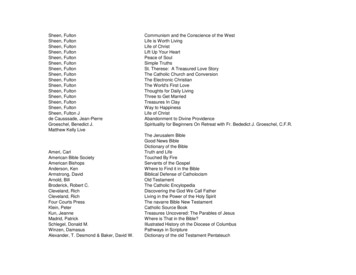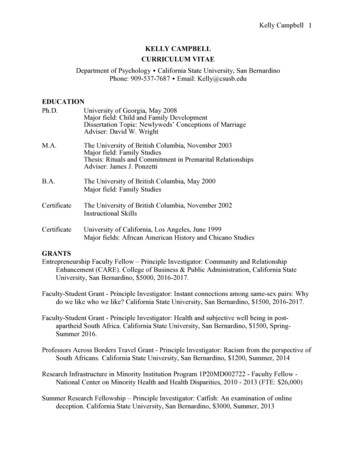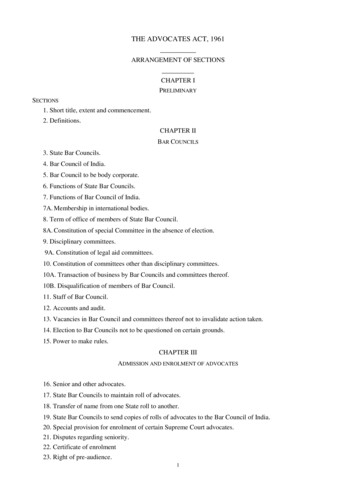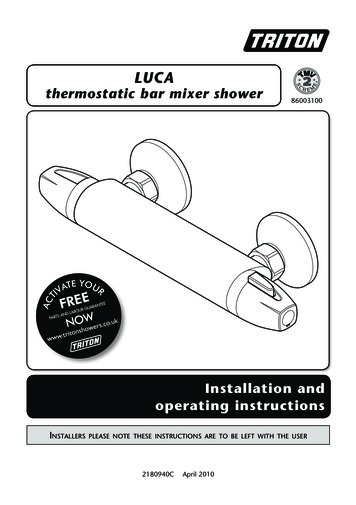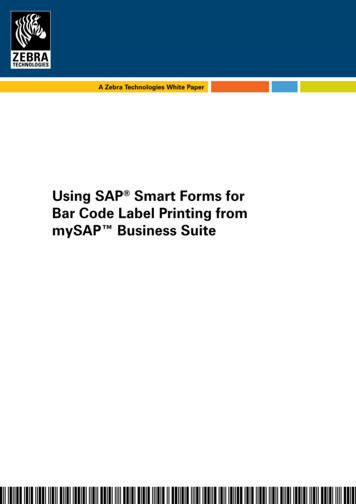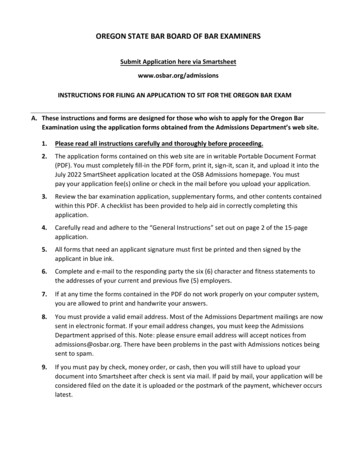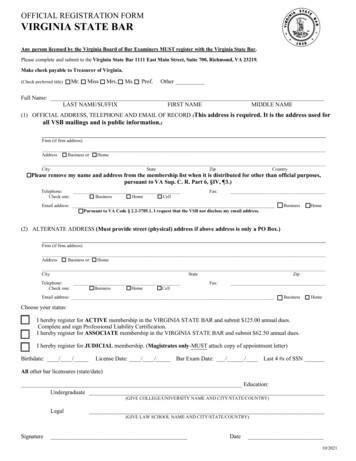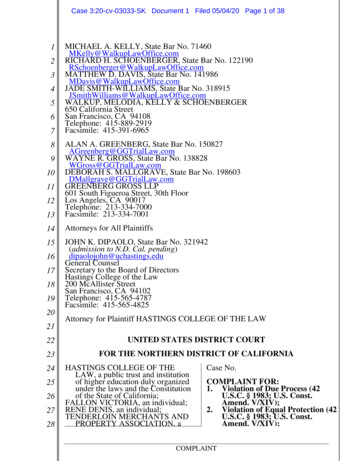
Transcription
Case 3:20-cv-03033-SK Document 1 Filed 05/04/20 Page 1 of 381234567MICHAEL A. KELLY, State Bar No. 71460MKelly@WalkupLawOffice.comRICHARD H. SCHOENBERGER, State Bar No. 122190RSchoenberger@WalkupLawOffice.comMATTHEW D. DAVIS, State Bar No. 141986MDavis@WalkupLawOffice.comJADE SMITH-WILLIAMS, State Bar No. 318915JSmithWilliams@WalkupLawOffice.comWALKUP, MELODIA, KELLY & SCHOENBERGER650 California StreetSan Francisco, CA 94108Telephone: 415-889-2919Facsimile: 415-391-696513ALAN A. GREENBERG, State Bar No. 150827AGreenberg@GGTrialLaw.comWAYNE R. GROSS, State Bar No. 138828WGross@GGTrialLaw.comDEBORAH S. MALLGRAVE, State Bar No. 198603DMallgrave@GGTrialLaw.comGREENBERG GROSS LLP601 South Figueroa Street, 30th FloorLos Angeles, CA 90017Telephone: 213-334-7000Facsimile: 213-334-700114Attorneys for All Plaintiffs15JOHN K. DIPAOLO, State Bar No. 321942(admission to N.D. Cal. pending)dipaolojohn@uchastings.eduGeneral CounselSecretary to the Board of DirectorsHastings College of the Law200 McAllister StreetSan Francisco, CA 94102Telephone: 415-565-4787Facsimile: 415-565-4825891011121617181920Attorney for Plaintiff HASTINGS COLLEGE OF THE LAW2122UNITED STATES DISTRICT COURT23FOR THE NORTHERN DISTRICT OF CALIFORNIA2425262728HASTINGS COLLEGE OF THELAW, a public trust and institutionof higher education duly organizedunder the laws and the Constitutionof the State of California;FALLON VICTORIA, an individual;RENE DENIS, an individual;TENDERLOIN MERCHANTS ANDPROPERTY ASSOCIATION, aCase No.COMPLAINT FOR:1. Violation of Due Process (42U.S.C. § 1983; U.S. Const.Amend. V/XIV);2. Violation of Equal Protection (42U.S.C. § 1983; U.S. Const.Amend. V/XIV);COMPLAINT
Case 3:20-cv-03033-SK Document 1 Filed 05/04/20 Page 2 of 3812business association;RANDY HUGHES, an individual; andKRISTEN VILLALOBOS, anindividual;345Plaintiffs,v.3.4.5.6CITY AND COUNTY OF SANFRANCISCO, a municipal 3.14.16171819202122232425262728COMPLAINTViolation of Due Process Clause,State-Created Danger Doctrine(42 U.S.C. § 1983; U.S. Const.Amend. XIV);Uncompensated Taking(42.U.S.C. § 1983; U.S. Const.Amend. V/XIV);Municipal Liability forUnconstitutional Custom orPolicy (42 U.S.C. § 1983);Violation of Title II of theAmericans with Disabilities Act(42 U.S.C. §§ 12131 et seq.);Violation of Section 504 of theRehabilitation Act (29 U.S.C.§§ 794 et seq.);NegligencePublic Nuisance (Cal. Civ. Code§§ 3490 et seq.);Private Nuisance (Cal. Civ. Code§§ 3501 et seq.);Violation of Mandatory Duty(Cal. Gov’t Code § 815.6;Cal. Welf. & Inst. Code § 17000);Deprivation of the Guarantee ofSafety and the Pursuit ofHappiness (Cal. Const. art. I § 1);Inverse Condemnation(Cal. Const. art. I § 19);Violation of California DisabledPersons Act (Cal. Civ. Code§§ 54 et seq.)
Case 3:20-cv-03033-SK Document 1 Filed 05/04/20 Page 3 of 38I. INTRODUCTION121.San Francisco’s Tenderloin neighborhood faces a desperate crisis.32.The Tenderloin is a culturally diverse community comprised of4seniors, persons with disabilities, people of color, immigrants (documented and5undocumented), individuals with low incomes, LGBTQ people, and families6with children. All of its residents—housed and unhoused—are being put at risk7by the policies, actions, and inaction of the City and County of San Francisco.893.Even before the onset of the COVID-19 pandemic, the de factopolicy of the City and County of San Francisco to use the Tenderloin10community as a containment zone had resulted in a dramatic decline in the11livability and safety of the neighborhood. The deplorable conditions tolerated12by the City in the Tenderloin are not permitted in other neighborhoods in San13Francisco. This is a matter of fundamental fairness; what is a city-wide problem14should not be allowed to weigh disproportionately on a low-income working-15class neighborhood. San Francisco should be prohibited from abandoning a16single neighborhood, in an apparent effort to spare other neighborhoods the17burdens that confront the city at-large.184.The Tenderloin, always a community of tolerance and compassion,19is now blighted; its sidewalks are unsanitary, unsafe, and often impassable.20Open-air drug sales and other criminal activity, plus crowds of drug users and21sidewalk-blocking tents, pervade and threaten the health and lives of all of the22Tenderloin’s residents. What has long been suffered in the Tenderloin has23become insufferable. The conditions now prevailing in the Tenderloin24constitute a violation of the fundamental civil rights of those residing and25working there.265.Small business owners, who reflect the cultural diversity of the27neighborhood, face multiple challenges. Their economic viability is threatened28by generic COVID-19 business disruption, but they must also cope with an-1COMPLAINT
Case 3:20-cv-03033-SK Document 1 Filed 05/04/20 Page 4 of 381existential risk to their future, as customers elect to patronize establishments2where sidewalk conditions do not impose physical barriers to safe access.6.3The pandemic has ominously exacerbated dangers and harms to4those who live, work, and go to school in the Tenderloin, and it threatens to do5so for years to come as successive waves of infection bring further death and6despair.77.Plaintiffs make the factual allegations and assert the legal claims8herein in an effort to compel the City and County of San Francisco to comply9with the law. Plaintiffs seek ultimately not to assign blame, but to obtain legally10obligatory solutions.II. JURISDICTION AND VENUE118.12Plaintiffs assert the claims herein pursuant to 42 U.S.C. § 1983; the13Americans with Disabilities Act, 42 U.S.C. §§ 12131 et seq. (the “ADA”);14Section 504 of the Rehabilitation Act of 1973, 29 U.S.C. §§ 794 et seq.15(“Section 504”); and the Fifth and Fourteenth Amendments of the United States16Constitution. This Court has jurisdiction pursuant to 28 U.S.C. §§ 1331, 1343,171367, 2201 & 2202.9.18This Court has supplemental jurisdiction over Plaintiffs’ state law19claims pursuant to 28 U.S.C. § 1367, as they arise from the same case or20controversy as Plaintiffs’ federal claims.10.21Plaintiffs seek only equitable and injunctive relief for their state22law claims. Accordingly, Plaintiffs need not submit a compensation claim with23any local public entity pursuant to the California Tort Claims Act,24Cal. Gov’t Code §§ 810 et seq.125///26///27281See Qwest Commc’ns Corp. v. City of Berkeley, 146 F. Supp. 2d 1081,1090-91 (N.D. Cal. 2001).-2COMPLAINT
Case 3:20-cv-03033-SK Document 1 Filed 05/04/20 Page 5 of 3811.1The acts and omissions complained of herein occurred in the2Northern District of California. Accordingly, pursuant to 28 U.S.C. § 1391,3venue is proper in this Judicial District.III. INTRADISTRICT ASSIGNMENT412.5A substantial part of the events or omissions that give rise to the6claims asserted herein occurred in the City and County of San Francisco, and a7substantial part of the property that is the subject of this action is situated in the8City and County of San Francisco.IV. PARTIES910A.Plaintiffs13.11Plaintiff HASTINGS COLLEGE OF THE LAW (“Hastings”) is a12public trust and institution of higher education duly organized under the laws13and the Constitution of the State of California. Hastings was established in141878 and has been an American Bar Association-approved law school since151939. Hastings is located in the Tenderloin. Hastings’ administrative offices16and some academic space are at 200 McAllister Street; classrooms and faculty17offices are at 333 Golden Gate Avenue and 198 McAllister Street; and 10018McAllister Street—commonly known as “The Tower”—contains other offices19and 252 units of student housing.14.20Plaintiff FALLON VICTORIA is an individual and a manager of21the Pierre Hotel, an SRO (“single-resident occupancy”) facility that provides 8622units of permanent housing, with many units occupied by formerly homeless23individuals. The Pierre Hotel is located in the Tenderloin, on Jones Street24between O’Farrell and Geary.15.25Plaintiff RENE DENIS is an individual and, since 2008, the26managing partner and part owner of Soluna Cafe and Lounge, a restaurant27located in the Tenderloin, at 272 McAllister Street.28///-3COMPLAINT
Case 3:20-cv-03033-SK Document 1 Filed 05/04/20 Page 6 of 3816.1Plaintiff TENDERLOIN MERCHANT AND PROPERTY2OWNERS (the “TMA”) is an association of owners of businesses in the3Tenderloin. The TMA was established in 2019 to improve the conditions4around their storefronts for the benefit of neighbors and customers. TMA’s5membership reflects the diversity of the Tenderloin including its many6immigrant owned businesses.17.7Plaintiff RANDY HUGHES is an individual and a resident in the8Tenderloin, at 380 Ellis Street, also known as the Cadillac Hotel. The Cadillac9Hotel consists of 156 units of permanent affordable rental housing for low-10income individuals. Plaintiff HUGHES is dependent on a wheelchair due to his11physical disabilities.18.12Plaintiff KRISTEN VILLALOBOS is an individual and a resident13at an apartment building located on Golden Gate Avenue near the corner of14Larkin Street. She and her husband have lived in the Tenderloin for 12 years.15B.Defendant19.16Defendant CITY AND COUNTY OF SAN FRANCISCO17(“Defendant” or the “City”) is a municipal entity existing under the laws of the18State of California, with the capacity to sue and be sued.V. FACTUAL ALLEGATIONS192021A.History of the Tenderloin Neighborhood20.The “Tenderloin” is an approximately 50-city block neighborhood22in downtown San Francisco that has been known by that name for more than a23century. Although not all authorities agree on the Tenderloin’s precise metes24and bounds, the trapezoid-shaped region is roughly bordered on the west by Van25Ness Avenue, on the north by Post Street, on the east by Mason Street, and on26the south by Market Street.272821.For most of its existence, the Tenderloin has attracted residentsfrom the working-class and lower income segments of San Francisco society.-4COMPLAINT
Case 3:20-cv-03033-SK Document 1 Filed 05/04/20 Page 7 of 381The socioeconomic fortunes of the Tenderloin have waxed and waned2significantly over the past 60 years.22.3Specifically, the distinctive character of the Tenderloin experienced4a sharp decline in the 1960s. By 1971, the neighborhood was described by The5New York Times as the “porn capital of the USA.”2 Prostitution and illegal drug6trafficking were open and notorious, and housing conditions deteriorated.323.7A decade later, in the early to mid-1980s, the Tenderloin enjoyed a8brief revival. Through the hard work, dedication, and inspiration provided by9politicians and community leaders including then-Mayor Dianne Feinstein; the10Reverend Cecil Williams of Glide Memorial United Methodist Church; and the11late owner of the Cadillac Hotel, Leroy Looper, the Tenderloin attracted12substantial fresh investment, particularly in its restaurants and other small13businesses.4 New zoning regulations were enacted that protected the low-14income character of the neighborhood.524.15Unfortunately, the Tenderloin’s economic resurgence did not last.16By the late-1980s, several factors, including a cut in federal funding, an17economic slump, and a lack of police department support, triggered another18two-decade decline.619///2021222324252Randy Shaw, After 40 Years, the Tenderloin at Another Crossroads, SanFrancisco Chronicle (Feb. 23, hp (referring to William Murray, Porn Capital of America:San Francisco, New York Times Magazine (Jan. 3, 1971), at 8-9).3See generally Randy Shaw, The Tenderloin: Sex, Crime, and Resistancein the Heart of San Francisco 135-56 (2015) (Chapter 6: 1967-1977, TheTenderloin Hits Bottom).264Shaw, S.F. Chronicle, supra n.2.275Id.286Id.-5COMPLAINT
Case 3:20-cv-03033-SK Document 1 Filed 05/04/20 Page 8 of 3825.1For a few years beginning in 2011, under the leadership of the late2Mayor Ed Lee, the Tenderloin again experienced a revitalization. New housing3and restaurants opened, neighborhood parks were renovated, and the Tenderloin4Museum was commissioned.7 But, again, the Tenderloin’s prosperity did not5last.6B.Current State of the Tenderloin26.7At present, more than 20,000 people are permanent residents of the8Tenderloin, including 3,000 children.8 Indeed, the Tenderloin has the highest9per capita concentration of children of any neighborhood in San Francisco.910The Tenderloin’s residents consist primarily of low-income and working class11individuals, senior citizens, disabled people, and families with children.1027.12By 2019, the condition of the Tenderloin sank to a new low. The13homeless population, which has long been present in the Tenderloin, swelled.14According to a 2019 study conducted by Applied Survey Research, the15homeless count in San Francisco increased by almost 20% over the four years16from 2015 to 2019, with most of that growth occurring over the last two years.1128.17181920The recent influx of homeless people into the Tenderloin hascreated a variety of problems for all stakeholders—permanent residents,7Id.821Randy Shaw, SF Turning Tenderloin into a Ghetto, BeyondChron(Apr. 7, 2020), a-ghetto/.2292324Carrie Sisto, Tenderloin Merchants Form New Association to AddressIssues with Neighborhood’s Alleys, Hoodline (Nov. 13, eighborhood-s-alleys.251026112728Shaw, BeyondChron, supra n.8.Applied Survey Research, San Francisco Homeless Count & Survey 2019Executive Summary, San Francisco Department of Homelessness & SupportiveHousing (2019), mmary SanFrancisco2019.pdf.-6COMPLAINT
Case 3:20-cv-03033-SK Document 1 Filed 05/04/20 Page 9 of 381businesses, schools, the police, and the homeless population itself (an estimated239% of whom suffer from mental illness12).29.3Open-air drug transactions are routinely tolerated in the Tenderloin.4The easy availability of illegal drugs attracts users and intensifies the5homelessness problem. Some 42% of the homeless population are estimated to6suffer from alcohol or drug addiction.1330.7Sidewalks in the Tenderloin are now packed with tents, some of8which contain as many as six individuals. Displayed below is a photograph9taken on April 11, 2020, that shows one such heavily occupied tent on the10southeast corner of Jones and Golden MPLAINT
Case 3:20-cv-03033-SK Document 1 Filed 05/04/20 Page 10 of g to a count conducted by Urban Alchemy (a non-profit24organization that provides litter reduction services in the Tenderloin and25adjacent neighborhoods of San Francisco to ensure safe, clean, and accessible26sidewalks and rights-of-way), the number of tents and makeshift shelters on27Tenderloin sidewalks grew from 158 on March 3, 2020, to 391 on May 1, 2020.28A chart illustrating the increase in the number of those tents and shelters on-8COMPLAINT
Case 3:20-cv-03033-SK Document 1 Filed 05/04/20 Page 11 of 381Tenderloin sidewalks from December 10, 2019, to May 1, 2020, is set forth2below.3456789101112131432.15Those tents block the sidewalks in the Tenderloin, impeding16pedestrians’ travel. They also serve as cover for drug dealers and others17conducting nefarious activities.14 However, the San Francisco Police18Department has been directed not to remove or disturb those tents, despite the19facts that they block the sidewalks and shield criminals and despite the health20risks that they pose to permanent residents, business owners, pedestrians, and21homeless people themselves.15 Displayed below is a photograph of the corner22of Golden Gate and Leavenworth, taken on April 27, 2020, that shows a line of23such tents.242526272814Phil Matier, SF Homeless Tents, Once Seen as Problem, Now Seen asPath to Coronavirus Social Distancing, San Francisco Chronicle (Apr. 12,2020), n-15193812.php.15Shaw, BeyondChron, supra n.8.-9COMPLAINT
Case 3:20-cv-03033-SK Document 1 Filed 05/04/20 Page 12 of 28According to Randy Shaw, executive director of the TenderloinHousing Clinic,16 “The Tenderloin has become a horror show. Feces, drug16Mr. Shaw also co-founded and serves on the Board of Directors ofUptown Tenderloin, Inc., a nonprofit organization that in 2009 spearheaded thecreation of the national Uptown Tenderloin Historic District. UptownTenderloin, Inc. was the driving force behind the Tenderloin Museum, whichopened in 2015. Mr. Shaw is the editor of BeyondChron.org.-10COMPLAINT
Case 3:20-cv-03033-SK Document 1 Filed 05/04/20 Page 13 of 381dealers and users, graffiti, tents and crowds on sidewalks dominate the2landscape.”17 As an example, displayed below is a photograph taken on3April 16, 2020, that shows a crowd on the corner of Turk and Hyde lth problem.2535.26The crisis in the Tenderloin presents an immediate and dire publicThe Tenderloin’s crisis also presents an environmental problem, asthe U.S. Environmental Protection Agency has recognized. In a letter to272817Shaw, BeyondChron, supra n.8.-11COMPLAINT
Case 3:20-cv-03033-SK Document 1 Filed 05/04/20 Page 14 of 381Governor Gavin Newsom dated September 26, 2019, EPA Administrator2Andrew R. Wheeler wrote:3The EPA is aware of the growing homelessness crisis4developing in major California cities, including Los Angeles and5San Francisco, and the impact of this crisis on the environment.6Indeed, press reports indicate that “piles of human feces” on7sidewalks and streets in these cities are becoming all too common.8The EPA is concerned about the potential water quality impacts9from pathogens and other contaminants from untreated human10waste entering nearby waters. San Francisco, Los Angeles and the11state do not appear to be acting with urgency to mitigate the risks12to human health and the environment that may result from the13homelessness crisis.181436.The plight of the Tenderloin is aggravated by the NIMBY19 attitude15and behavior exhibited by many in San Francisco. That is, as the streets of16other San Francisco neighborhoods improve, the condition of the Tenderloin17deteriorates. As San Francisco Chronicle columnist Heather Knight recently18observed, “Though city officials would never admit it, they’ve long treated the19low-income neighborhood [of the Tenderloin] as a containment zone, tolerating20everything from blatant drug dealing to open-air injection drug use to filthy21sidewalks that wouldn’t stand in wealthier parts of town.20 Randy Shaw2223242526272818Letter from Andrew R. Wheeler, Administrator, U.S. EnvironmentalProtection Agency, to Gavin C. Newsom, Governor, State of California(Sep. 26, 2019), documents/9.26.19 letter-epa.pdf (footnotes omitted).19“Not In My Back Yard”20Heather Knight, “The Problem Is Getting Worse”: SF’s TroubledTenderloin Buckles under Weight of Coronavirus, San Francisco Chronicle(Apr. 17, 2020),-12COMPLAINT
Case 3:20-cv-03033-SK Document 1 Filed 05/04/20 Page 15 of 381similarly asserted, “in 2020, our ‘progressive’ city still maintains a double2standard that bars activities in gentrified neighborhoods that it allows in the3Tenderloin.”214C.Impact on Plaintiffs37.5Plaintiff Hastings’ facilities are on McAllister Street, Larkin Street,6Hyde Street, and Golden Gate Avenue in the Tenderloin, and Hastings students,7faculty, and staff have suffered from the deterioration of their community.8Tent-blocked sidewalks, groups of addicts injecting themselves, the odors of9smoked crystal methamphetamine and human waste, and open-air drug dealing10immediately outside the Tower cause residents to fear for their safety; many are11afraid to venture outside their building, particularly at night.38.12Hastings spent 66,836 on increased safety and security in the first13month following Public Health recommendations for the COVID-19 pandemic.14Hastings expended that sum in addition to the 2.3 million that it spends15annually on security; of this amount, half is spent on supplemental police—16sworn peace officers provided under contract with UCSF—with the remainder17spent on security guards controlling building access. Hastings also spent 2,10018per week (annualized to 109,200) for extra cleaning services—power washing19and trash pickup—from the Tenderloin Community Benefits district, over and20above Hastings’ annual property tax assessments. Those tax assessments21totaled 93,987 in 2019-20, an increase from 49,000 in the prior year.39.22Students who decline offers of admission to Hastings often cite the23neighborhood as a significant factor in their decisions. One such student stated24in a 2020 survey, “One of the big reasons I did not go to Hastings is the25homeless population surrounding the campus. I quite honestly did not feel 5206953.php.2821Shaw, S.F. Chronicle, supra n.2.-13COMPLAINT
Case 3:20-cv-03033-SK Document 1 Filed 05/04/20 Page 16 of 381and I could not imagine walking home alone at night. I was looking forward to2living in San Francisco, but was shocked by the magnitude of the drug use3surrounding the campus. . . . My family was harassed and approached by a drug4dealer when walking around the campus. I could not imagine attending school5in a place where this is a daily occurrence.”640.Another student who declined an offer of admission this year7stated, “This was a really hard decision for me. I felt that this school would8have been an honor to attend. However, I witnessed crime right outside the9entrance when I visited. While I appreciate the growth of not living in a bubble,10I just didn't feel safe and was more stressed than I wanted to be walking back to11my car.”1241.Litter and used needles are found every day around the Hastings13parking garage. Human feces and urine are found in the doorways. Staff have14to escort the homeless out of the garage regularly. Thieves break into cars.1542.Businesses in the Tenderloin have likewise suffered as a result of16the neighborhood’s decline. Hastings’ retail tenants Golden Era Restaurant and17Philz Coffee have suffered crime and vandalism such as broken shop windows.1843.Plaintiff VICTORIA has witnessed a drastic change in the19conditions of the streets and sidewalks of the Tenderloin in recent months, and20especially since the City enacted the emergency shelter-in-place ordinance in21response to the COVID-19 pandemic. She is an essential worker and continues22to manage the Pierre Hotel during the pandemic. When she walks from the23BART station to the hotel, the sidewalks along her path are now crowded with24tents, people, and belongings. Sometimes she has to walk in the street, among25car traffic, because the sidewalks are impassable. Many of the people living on26the streets and sidewalks openly urinate, defecate, and dump their trash on the27sidewalks or between parked cars. Illicit drug sales and hypodermic drug use28have become rampant and are conducted in the open. Many of the people-14COMPLAINT
Case 3:20-cv-03033-SK Document 1 Filed 05/04/20 Page 17 of 381camping on and occupying the sidewalks do not adhere to social distancing2rules for the pandemic; they congregate in large groups in close proximity,3without masks; they do not make way for other people who live and work in the4Tenderloin who are trying to use the sidewalks; they sometimes display hostile5and threatening behavior.644.Plaintiff VICTORIA has on numerous occasions seen members of7the San Francisco Police Department (“SFPD”) simply look away when people8on the streets and sidewalks of the Tenderloin commit crimes and engage in9conduct that threatens the health and safety of others. Plaintiff VICTORIA has10made numerous calls and contacts to the City and its agencies, asking them to11act, but to no avail. The tenants of the Pierre Hotel, many of whom are elderly12or have underlying health conditions, cannot safely venture outside of the hotel.13This means they cannot safely go to a store to buy food. Plaintiff VICTORIA14worries that the conditions of the sidewalks and streets of the Tenderloin15jeopardize the health and safety of her employees and the residents of the hotel.1645.On a personal level, Plaintiff VICTORIA is married with three17children, and she worries that if she contracts COVID-19 because of the18conditions of the sidewalks and streets of the Tenderloin, then she is putting her19family at risk, including one of her children who suffers from asthma and20allergies.2146.Plaintiff DENIS has witnessed a drastic change in the conditions of22the streets and sidewalks of the Tenderloin in recent months, and especially23since the City enacted the emergency shelter-in-place ordinance in response to24the COVID-19 pandemic. A line of tents obstructs the sidewalk near the25McAllister Street entrance of his restaurant, and they extend around the block26and continue up Larkin Street. Drug dealing and usage is rampant and27conducted in plain view of even the SFPD. Many of the people living on the28sidewalk and street near Plaintiff DENIS’ restaurant urinate, defecate, and throw-15COMPLAINT
Case 3:20-cv-03033-SK Document 1 Filed 05/04/20 Page 18 of 381their used syringes and trash on the sidewalk and street. Plaintiff DENIS has2observed a group of these people using a puddle near the curb as a place to3bathe and wash personal items. Many of the people living on the street and4sidewalk near his restaurant act hostilely and have threatened violence.547.While Plaintiff DENIS has kept his restaurant open for take-out6and deliveries during the pandemic, he will likely have to close that aspect of7the business because his clientele does not feel safe walking to his restaurants8and delivery drivers are afraid to come to his restaurant.948.Members of the TMA have witnessed a drastic change in the10conditions of the streets and sidewalks of the Tenderloin in front of and near11their businesses in recent months, and especially since the City enacted the12emergency shelter-in-place ordinance in response to the COVID-19 pandemic.13The members of the TMA have lost a significant amount of business because14the streets and sidewalks near their businesses are filthy and unsafe and, in some15locations, literally impassable.1649.Plaintiff HUGHES has witnessed a drastic change in the conditions17of the streets and sidewalks of the Tenderloin in recent months, and especially18since the City enacted the emergency shelter-in-place ordinance in response to19the COVID-19 pandemic. The sidewalks in front of his residence and nearby20streets are now congested with tents and encampments. The hygiene of the21people living and congregating around the Cadillac Hotel is atrocious, with22almost no one wearing masks or following social distancing rules. Illicit drug23sales and use are conducted openly and in the presence of the SFPD. While24Plaintiff HUGHES is fearful to leave the hotel because the conditions have25become so unsafe, he must do so to shop, run necessary errands, and perform26volunteer work. Many of the people living and congregating on the sidewalks27refuse to get out of the way and block his path as he tries to navigate through the28neighborhood in his wheelchair. He is afraid of being attacked for simply-16COMPLAINT
Case 3:20-cv-03033-SK Document 1 Filed 05/04/20 Page 19 of 381“inconveniencing them” by trying to use his wheelchair on the sidewalk.2Plaintiff HUGHES often has to detour out into the street and into traffic because3the sidewalks are blocked.50.4Plaintiff VILLALOBOS has witnessed a drastic change in the5conditions of the streets and sidewalks of the Tenderloin in recent months, and6especially since the City enacted the emergency shelter-in-place ordinance in7response to the COVID-19 pandemic. Now, drug dealers and drug users8congregate in front of her apartment building and make it impossible for her or9any others to enter or exit the building without walking very close to them. She10regards them as threatening and intimidating. The people congregating in front11of her building do not follow social distancing rules related to the pandemic, and12the only ones who wear masks are the drug dealers. However, now the drug13dealers openly laugh and scoff at members of the SFPD who pass by. Many of14the sidewalks near her home are impassible due to tents, encampments, and15congregations of filthy people, forcing her to walk in the street. She and her16husband will now walk blocks out of their way to avoid some of the especially17bad streets and sidewalks.51.18There are families with young children who live in Plaintiff19VILLALOBOS’ apartment building, and she feels especially distraught about20their plight. The families are afraid even to walk outside of the apartment21building. The children now play games in the common hallways of the22building.23D.Effect of the COVID-19 Pandemic52.24On March 16, 2020, in response to the COVID-19 pandemic,25Mayor London Breed directed San Francisco businesses to close and issued a26citywide shelter-in-place order.22 The homeless population in the Tenderloin,272822Russell Berman, The City That Has Flattened the Coronavirus Curve,The Atlantic (Apr. 12, 2020),-17COMPLAINT
Case 3:20-cv-03033-SK Document 1 Filed 05/04/20 Page 20 of 381however, have no place in which to shelter. Homeless people are exempted2from social distancing conventions. Hastings officials are deeply concerned that3a significant portion of the homeless p
WALKUP, MELODIA, KELLY & SCHOENBERGER 650 California Street San Francisco, CA 94108 Telephone: 415-889-2919 Facsimile: 415-391-6965 ALAN A. GREENBERG, State Bar No. 150827 AGreenberg@GGTrialLaw.com WAYNE R. GROSS, State Bar No. 138828 WGross@GGTrialLaw.com DEBORAH S. MALLGRAVE, State Bar No. 198603 DMallgrave@GGTrialLaw.com

